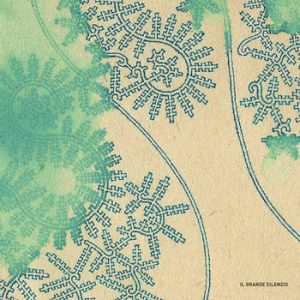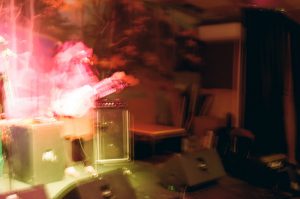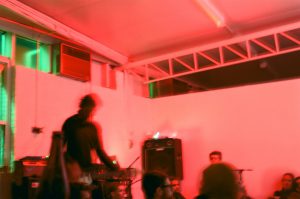“Wasted in the Waiting” is a re-release from the digital-only release from 2020, now on cassette available through Cosmic Winnetou (Thank you, Günter). So as a re-release, I usually would have spent a bit less time, but … As it was digital only, it has not yet been reviewed in Vital Weekly. So: Yeah! New Celer! “Wasted in the Waiting” is a 2-track album, “Unreality in Misfortune” counts 38 minutes, “Mere Threads” is almost 46. So if you just read the Modelbau review, you already see me being happy: Long meandering tracks with subtle behaviour are the audible territory. And yes, “Unreality in Misfortune” is a perfect example, even with the abrupt ending. The build-up is massive, the choice of orchestral sounds significant, and it seems endless. Then, “Mere Threads”. The beginning is about the best I’ve ever heard, and the track is Celer. It goes on and on and works best when played in the background to form ‘one’ with your environment … Hmm, now, where have I heard that before … Yes, the minimalism that is Celer is an acquired taste, but if you were to try something this minimal, you might as well try this one.
Posts from the Two Acorns Category
Choose another category?
Il Grande Silenzio reviewed by Shino Okamura
IL Grande Silenzioはドローイング・アーティストの小川敦生と、こちらも音楽家として活動中の佐藤実によるプロジェクト。一筆書きで丹念に描かれた小川のド ローイング作品はこれまでに国内外で高く評価され、過去に展示、個展も多く開催されてきました。小川は音源制作にも積極的で、生楽器とエレクトロニクス を、時に優雅に、時に厳しく交配させながらドローイング作品さながらの繊細なアルバムを発表してきています。
カルト映画『殺しが静かにやってく る』(ジャン・ルイ・トランティニアン主演)の原題と同じユニット名、同じタイトルを与えたこの作品では、バンジョー(小川)のノスタルジックで線の細い 音色と、微かなノイズを奏でるプログラミング(佐藤)とが、ゆったりとしたタイム感の中で1音1音を互いに響かせ合っています。その様子は、さながら日の 翳りゆく砂漠でポツリポツリと会話する二人の男、といったところ。ライ・クーダーによる『パリ、テキサス』のサントラ以上に苦(にが)い寂寞をこちらにゆ るやかにつきつけてくるようです。素晴らしいの一言。
なお、このアルバムは現在Amazonなどでの取り扱いはまだないようなので、近くにショップがない方は、小川さんご本人に直接尋ねてみることをおすすめします。小川さんはツイッターにもいらっしゃいますよ。
Il Grande Silenzio in maeror3
Японские музыканты Минору Сато и Атсуо Огава взяли из «спагетти-вестернов» не только название «Il Grande Silenzio» для своего дуэта, но и очень известный, хотя и далеко не всеми любимый и воспринимаемый без иронии инструмент банджо. На нем играет Огава, добавляя иногда звучание своего голоса (как правило, неразборчивое бормотание или тихое завывание), в то время, как Сато извлекает звуки из самодельного, существующего в единственном экземпляре инструменте «RP3M», или же «roll paper punching program machine» – не сильно удивлюсь, если это каким-то хитрым образом переработанный факс или принтер. Для дуэта этот альбом стал дебютным, но его участники довольно известны в мире экспериментальной музыки, а появлению диска на свет способствовало их знакомство и совместные перфомансы с проживающим ныне в Японии Уиллом Лонгом («Celer»), который и издал «Il Grande Silenzio» своем лейбле «Two Acorns».
Я как-то стал замечать за собой (минутка объективности), что с годами все труднее воспринимаю японскую импровизационную музыку. Видимо, разница менталитетов или наращиваемый, надеюсь, с годами опыт слушателя, делают нас, простого россиянина и сынов страны Восходящего Солнца, все дальше друг от друга в эстетическом плане. Гарантией хорошо проведенного времени в компании с этой музыкой для меня стало участие Лонга хотя бы в качестве издателя и полное доверие его вкусу – но, о вкусах не спорят даже с очень уважаемым музыкантом, так что придется констатировать, что та грань реальности, на которой эксперименты японского дуэта представляют хоть какой-то интерес, находится от меня на некотором отдалении. Что же здесь происходит? Как звучит музыка, которую сами авторы посвятили навсегда ушедшим от нас вещам, еле слышные звуки которых еще доносятся до нас эхом? Совсем не так, как это звучало бы у тех же «Celer». С первых же минут фантазия рисует заброшенный, но, надо отдать должное, светлый и заботливо ухоженный пустой сарайчик где-то на пересечении пыльных дорог безграничной прерии. В нем и сидят два человека, один из которых очень монотонно перебирает струны банджо, периодически оглашая замкнутое пространство тихим, бессвязным напевом или обрывками фраз, а второй издает с помощью неведомой машины разные шумы. Шумы цикличные и довольно миролюбивые, как правило, это позвякивание в такт колокольчиков или дребезжащие звуки, не заполняющие все пространство и оставляющие много места для тишины. Не забыта и акустика помещения, очень точно переданы скрипучие шаги, шарканье, блуждание ветра за тонкими деревянными стенами. Сказать, что помимо этого в мирке «Il Grande Silenzio» происходит что-то очень интересное в творческом и культурном плане я не могу, это импровизация «под настроение», видимо, нужно быть немного японцем (любящем итальянские вестерны), чтобы понять всю суть происходящего. Заторможенность музыки прорывается только один раз, в «Rust», когда шумы на несколько минут позволяют себе заполнить все вокруг своим клокотанием, показывая, что и здесь что-то может меняться и развиваться.
Одним словом, материал на любителя. Любители восточной импровизационной и экспериментальной музыки – обратите внимание на «Il Grande Silenzio».
Il Grande Silenzio in Vital Weekly
Its been a while since I last heard something by Minoru Sato, who is best known from the highly conceptual label WrK which he ran from 1994 to 2006. They released musical works in a scientific context, from installations and such like, and dealt usually with one ‘thing’ per release. Later on he released a CD with Asuna on the Spekk label (see Vital Weekly 601), but then it was quiet again. Here he teams up with one Atsuo Ogawa, who draws and paints, but also plays the banjo and ‘provides voice’, at least on this disc. while Sato plays a self-built instrument, mysteriously named ‘RP3M’, and I have no clue what it is. They named themselves after a spaghetti western. All of the seven pieces were played through improvisation, and the shortest is just over two minutes and the longest close to nineteen. All of the pieces are played in the same slow tempo, and consist every time of the same thing: plucking the strings of the banjo, deep sighs (every now and then) and the obscure rattle coming from Sato’s instrument, which seems to me some kind of electronic thing, but at the same time I wouldn’t be surprised to know its something acoustic. Pieces sound strikingly similar at times, and one doesn’t know a new piece has started. Very much like a lot, if not all, of the previous work of mister Sato this has a strong conceptual edge, but whereas that previous work was almost drone like in approach, exploring sound phenomena, this one is from a more musical perspective and it doesn’t work too well for me. Well into the third, say about twenty minutes into this CD, I know what it is about, and then I find out that the whole thing is over fifty-five minutes; but I already know what it sounds like, so I don’t need to hear the entire release that extensively, save perhaps for ‘Rust’ and ‘Kettle’, two short ones in which, all of a sudden Sato’s instrument sound distinctly different, longer sustaining and drone like. Why not explore that a bit more? Thus one is left behind, bemused and puzzled, but perhaps not entirely satisfied.
Il Grande Silenzio
The new release of Two Acorns, by Il Grande Silenzio, will be released September 1.
Within an extremely slow tempo, the raw sounds by banjo and self-built equipment by Il Grande Silenzio barely form a shape of music, like the soundtrack for silent characters in a monotone world. Il Grande Silenzio, the name taken from the title of a spaghetti western, is Minoru Sato and Atsuo Ogawa, both of which are working in the field of contemporary art.
Minoru Sato plays the self-built instrument “RP3M”. Atsuo Ogawa plays banjo, and provides voice. The music pieces of this first album were recorded between Autumn 2009 and Spring 2010. ‘home’ and ‘OTO’, made by an approach to improvisation, represents the original form of Il Grande Silenzio’s free-style sessions. ‘November’ and “forest” were formed by repeating simple phrases for long durations. Inside the music is an ambiguous harmony, like a new form of extreme folk music.
IL GRANDE SILENZIO : Biography :
Minoru Sato
Minoru Sato has an interest in a relationship between the description of nature and an art representation. He is creating artworks per physical phenomena and various concepts. His activities are explored in the form of installations, multiples, performances and texts.
He ran the label “WrK” from 1994 to 2006. Now he is producing music pieces by solo, collaboration with ASUNA and others. He is organizing various contemporary art exhibitions/events as a curator.
http://www.ms-wrk.com/
Atsuo Ogawa
Our hands move spontaneously, and for Atsuo Ogawa, drawing a line is as natural as breathing, never knowing when and where to stop. His drawings of delicate patterns consist of one line, and the support ranges from paper, glass, mirror, soap, wood and even to the wall or floor. Ogawa has been an active participant in many solo and group shows since the late 1990’s.
http://www.turqoiserosco.com/atsuo_ogawa.html
TWO ACORNS : Label Profile :
Founded in 2010, Two Acorns is a publisher of different types of art forms ranging from music, to books, to film, and is combined with original packaging, with a focus on sentimentality in all its forms, new and old, shelved and worn, perfect and new. These are things you can hold in your hand, or keep on your bookshelf, to keep these feelings, memories, and experiences. There is no replacement for the smell of a book, the sound of a needle dropping on a record, or the consistently changing nature of our memories.
www.thesingularwe.org/twoacorns
celer.adr@gmail.com
Tour diary: Melbourne
More photos here:
Tour diary: Lorne
More photos here:
Tour diary: Great Ocean Road
More photos here:
Tour diary: Gold Coast
Tour diary: Brisbane
More photos here:
http://www.collapseboard.com/brisbane
http://www.katiefairservice.net.au
http://www.flickr.com/photos/teaplease
http://www.flickr.com/photos/mikohere













































































